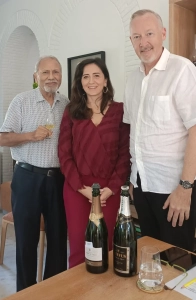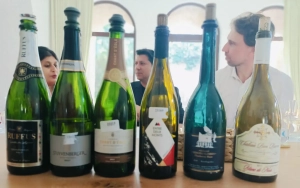
With Tüba and the Belgian Ambassador
First-ever Belgian Wines Tasting in Delhi

When you think of Belgium,you start salivating thinking of its chocolates, macarons and beer (if you drink the brew) but you might have not heard of it as a wine producing country though this seat of of European Parliament is surrounded by wine producing countries like Luxembourg, France and Germany at a short distance away.
Wine grapes have been grown in this region since the middle ages. In fact, early traces of wine go back to 9th century AD. During the middle ages monasteries played a pivotal role in winemaking. But viticulture in Belgium has been a relatively recent phenomenon. The Belgians have been investing in modern wine making and commercialization of it for a few decades only.
Despite this heavy emphasis on grain-based beverages like beer which seems to be the national brew with many Belgian beers present in India, it is also home to several wine-grape growing vineyards owned by families, making wine primarily for friends and family. There are around 100 vintners producing around 550 000 liters (around 60,000 cases of 12 bottles* 9liters) of wine primarily for domestic consumption. Although making wine is not commercialized in a big way, one can find small quantities in high-end restaurants where the connoisseurs love to taste the local ferment.
Therefore, it was quite a ceremony for the chosen few when Tuba Yargıç, opened 6 bottles of sparkling and white wines from her cellar of popular variants in Belgium for guests that included H.E. Mr. Didier Vanderhasselt, Belgian Ambassador and H.E. Ms. Ana Laban, Ambassador of Moldova -a keen wine enthusiast from a country that was a big producer of wine that was exported to Russia for their consumption but now exports to many countries.
Wine Grapes of Belgium
The white-grape varieties preferred by Belgium’s amateur vignerons are Chardonnay and Pinot Gris from across the border in France and Kerner, Muller-Thurgau and Optima from neighbouring Germany. The few red wines produced are made from a handful of Pinot Noir and Dornfelder grapes.
The meeting point of the Mosel and the Rhine, two of Europe’s great wine rivers, lies only 80 kilometers from Belgium’s eastern border. The Mosel forms the eastern border of Belgium’s tiny neighbor Luxembourg with a significantly higher per capita production. The Champagne capital Reims lies the same distance from Belgium’s southern border. This shows how close and yet how far Belgium is from being a commercial wine-producing country! Even the neighbouring Netherlands in the North has gotten into wine production though also on a similar small scale.
Wine tasting of 6 wines
1. Ruffus Chardonnay Brut this bubbly from Vignoble des Agaise made with the Traditional Method used to make Champagne, was light and elegant Aperitif wine, with a good balance of sweetness (around 6 gms/liter sugar). It showed hints of brioche and peach on the nose with notes of green apple and lemon on the palate, with a velvety texture. This sparkler would be great with fish starters and oysters. Alcohol level at 12.5% was slightly higher than that in Champagne. Elegance and lightness characterize this aperitif wine, which can also be paired with seafood. The wine is apparently quite popular, according to the Belgian Ambassador and has won many gold medals in several international wine competitions like Effervescent du Monde, Chardonnay du Monde and London Wine Competition.
The wine is priced between 20€ and 25 € in Belgium, according to Tüba.
2. Stuyvenberger Brut is made in the Flemish Region of Belgium (Flanders) and is a typical Champagne blend of Chardonnay (72%) and Pinot Noir (28%) by Wijngoed Stuyvenberg. Also made with ‘Méthode Traditionnelle’, aged for 2 years on the yeast for second fermentation. Consisting of 12% alc has also been judged as the best Belgian sparkling wine in competitions.
A bit tight on pouring, it opened up gradually becoming fruity with a hint of honey on the palate. It had good acidity and flavours of ripe white fruit and almonds. Priced at around €35, it seemed to appear a bit expensive for the quality.
3. Chant D’Éole Brut This Blanc de Blanc blend of 95% Chardonnay & 5% Pinot Blanc from Domaine du Chant D’Éole was also on the lees for 24 months and had been cellared for 18 months in the bottle. Trivia: This comes from an area full of windmills.
The Cuvée had excellent freshness, elegance and the roundness of Chardonnay, the signature grape variety of the Domaine. It had developed a golden yellow colour with a fine and delicate stream of bubbles. The moderate dosage of this wine and low Sulphur content had given it a perfect balance on my palate.
4. Entre Deux Monts Pinot LA Douve 2022
The Pinot la Douve is an assemblage of 3 Pinot grapes-Pinot Gris, Pinot Meunier and Pinot Noir. The alcohol percentage is 12%. The name La Douve is derived from the Douve Valley next to their vineyards, where the Douve has its source.
A fresh, aromatic and elegant wine with length and tension. The light yellow, bright and brilliant Pinot La Douve is ready to drink immediately and the young wine is best consumed within 2 years. Pure, mineral and elegant aromas with notes of fruits like apricot, peach, pear and yellow flowers with fresh, juicy fruit and fine acidity linger on with a long end.
It is a cool climate wine influenced by the North Sea. It has won many Gold medals, including the one in Belgium-based CMB (Concours Mondial de Bruxelles 2024) where I have been judging since 2009.
Priced at 15 euros this was an excellent value for money quality wine from a property with 17 hAs of vines.
5. Genoels Elderen Chardonnay Blauw 2020
WijnKasteel (wine castle) Genoels-Elderen owns 22 hAs of vines out of which 18 hA are used to grow Chardonnay and the rest are dedicated to Pinot Noir. It produces 10,000 cases a year. The winery is like a castle built over centuries of history, surrounded by a variety of vineyards. It has a state-of-the-art climate controlled wine cellar. Run by the Kekko-van Rennes family who works the terroir with considerable experience, love and patience, transforming it into a series of acclaimed wines to admire, smell, savour and enjoy. .
Chardonnay Blauw (blue) is the domain’s intermediate cuvée of dry white wines. It is vinified half in stainless steel tanks and half in French oak casks. It is then matured on lees with batonnage for a year (50% in tanks and 50% in casks). WijnKasteel Genoels-Elderen has 22 hAs of vines.
This pale gold coloured wine had aromas of floral and fruity perfumes with flavours displaying the flavour of ripe apples with slight smokiness in the end. The 2019 vintage we tasted had 13.5% Alc. It is priced at € 25,00.
6 Château Bon Baron Côte de Sambre et Meuse 2017

Located in Belgium, in the Meuse Valley, Château Bon Baron is an old wine estate that goes back to a winemaking tradition going back to 1018. A Dutch couple, Jeanette Van der Steen and her husband Piotr, embarked on a daring mission in 2001. They created a new successful winery in Belgium where viticulture had not prospered for centuries, by acquiring a castle in the Meuse valley and transforming it into Château Bon Baron. It is now known for producing high-class red wines and varied white wines.
This was the only Blanc de Noir in the tasting lineup. Very floral aromas and complex taste with long after taste. Priced at €18 this wine was very international in taste from a cool climate terroir.
All in all a very explorative tasting, that. It would not make sense for the Indian market but it certainly would tickle the fancy of a wine connoisseur interested in tasting wines of different countries and happily tick a box.
Subhash Arora




